How to Use AI in SEO: The Human-in-the-Loop Strategy That Actually Works
Everyone wants to believe AI can write perfect SEO content at the click of a button. It can’t.
And anyone selling you that story is selling you the off-brand—they’re not giving you Cheerios, they’re giving you Malt-O-Meal.
To use AI effectively in today’s age you must know how to use it. It’s not plug-and-play. You can’t just buy an AI powered SEO program off the shelf and expect instant results from Google search.
Trust me, I’ve tried several of them. They do the basics—and in a low-competition space, that might move the needle. But for serious SEO? They’re just glossing over everything.
We’re constantly testing new AI tools—not because we’re tech geeks (though we are), but because we want to tell our clients exactly what they’ll get before they invest a dollar. That’s why we test things. First of all, we want to understand it. When people say “hey I think I’m going to do this,” I want to be able to tell them okay, but here’s what you’re going to get.
AI is a tool. Just like you have to understand lefty-loosey and righty-tighty on a screwdriver, you have to understand how prompting and context and voice and generation techniques work with SEO. You have to understand the foundational stuff.
This guide shows you exactly how to use AI in SEO effectively—with the human input and oversight that separates results from disappointment.


Key Takeaways
- Master the fundamentals first: You must understand prompting, context, and SEO generation techniques before AI becomes truly useful (not plug-and-play)
- Human expertise is the quality gate: AI handles efficiency, humans handle emotional intelligence, brand voice, and that “final cherry on top”
- Test everything systematically: What works in low-competition spaces fails in competitive SEO—constant testing reveals what actually moves the needle
Why AI Tools Promise More Than They Deliver
In most cases, off-the-shelf AI SEO programs do the basics. So if you’re in an industry that doesn’t have a lot of competition, you may end up in a space where you start to rank better in search results.
But they’re essentially the off-brand. You can’t run a solid SEO campaign with those types of programs.
The gap between what AI tools promise and what they actually deliver comes down to strategic depth. Search engines like Google care about content quality and helpfulness, not whether AI was involved in creating content. When AI tools generate content without understanding search intent, user search intent, or the competitive landscape, they produce generic content that fails to rank.
The Off-Brand Problem: When AI Does the Basics
What do “the basics” mean in AI SEO context?
Basic AI powered seo tools handle surface-level optimization. They identify your primary keyword, sprinkle it throughout the content, add some related terms, and call it optimized. They might even hit your target word count and suggest a meta description.
But here’s what they miss:
- Search intent analysis beyond the obvious
- Competitive differentiation in your specific niche
- Brand voice consistency that builds trust
- Strategic internal linking that distributes authority
- Content depth that demonstrates actual expertise
That’s why basic optimization isn’t enough for competitive keywords. The difference between ranking and ranking well is the strategic layer that AI tools can’t provide without human direction.
What Low-Competition Success Hides
Here’s the thing about low-competition industries: almost any content strategy works temporarily.
If you’re the only HVAC company in a rural area actively publishing blog content, even mediocre AI generated content will probably rank. There’s simply no competition to beat you in search results.
But this creates false confidence. Business owners think “AI SEO works!” when really they’re succeeding despite the AI limitations, not because of AI capabilities.
The competitive threshold where AI-only approaches fail is lower than most people realize. According to recent industry research, 86.5% of top 20 Google positions contain at least partially AI-generated content—but purely AI content rarely reaches position #1 organically. The winners all have something in common: human expertise and editorial oversight.
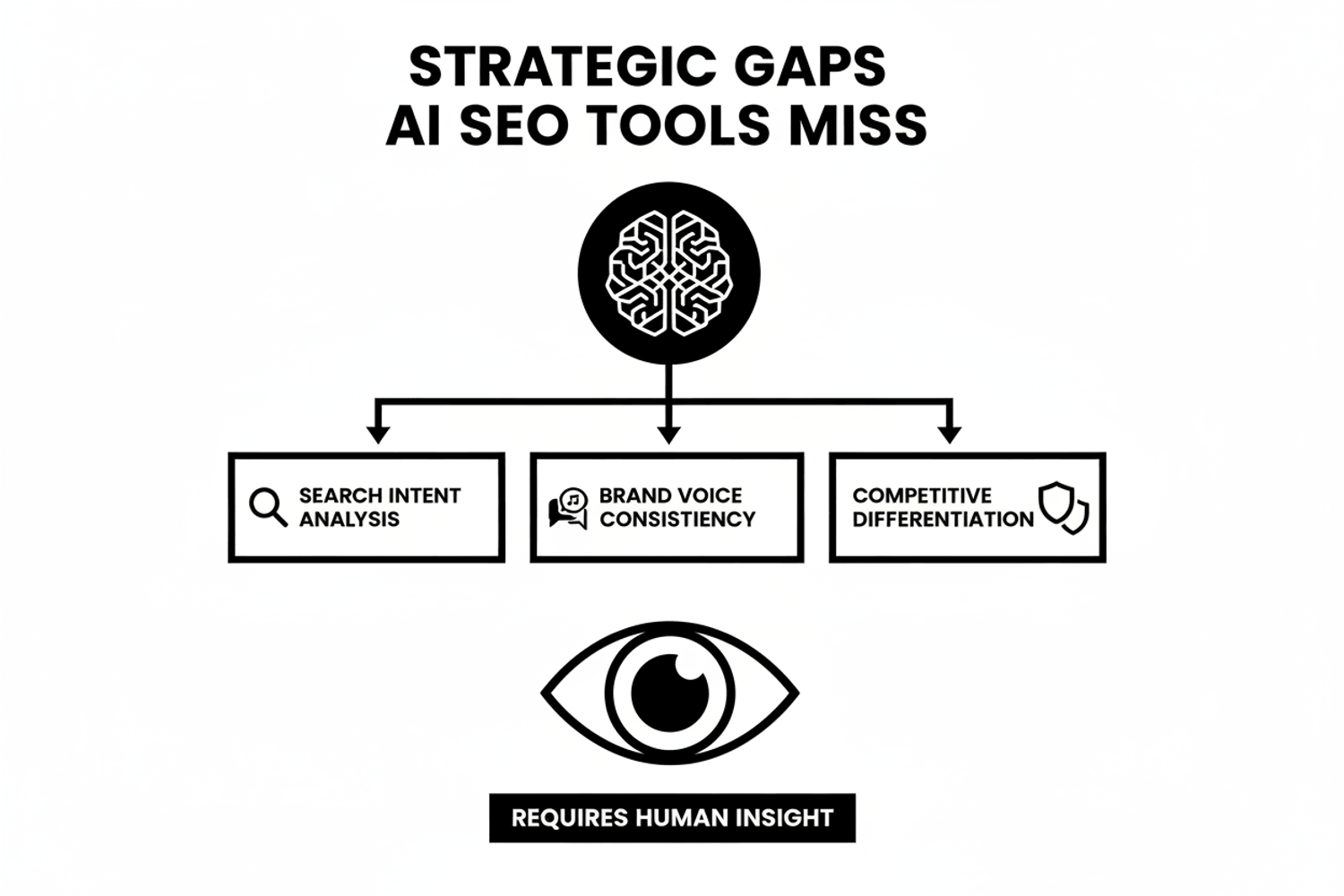

What You Must Know Before AI Becomes Effective
AI is a tool. And just like you have to understand lefty-loosey, righty-tighty on a screwdriver, you have to understand how prompting and context and voice and generation techniques work with AI. How they tie in to processes and systems and scripts.
This is why you can’t buy an SEO program off the shelf that’s powered by AI and instantly get results from search engines.
There are three foundational skills you need to master before AI becomes truly effective for search engine optimization.
Understanding Prompting and Context
Most people approach AI with vague requests: “Write a blog about teeth whitening.”
That’s not prompting. That’s hoping.
Effective prompting means giving AI specific instructions about what you need, why you need it, who it’s for, and what success looks like. It means understanding how context shapes AI output quality.
When you ask AI to generate content for SEO, you need to provide:
- Target keyword and search intent
- Audience knowledge level and pain points
- Brand voice and tone requirements
- Competitive positioning context
- Structural requirements (word count, headers, formatting)
The difference between asking and instructing AI determines whether you get generic fluff or a solid first draft worth refining.
Context management is equally critical. AI doesn’t “remember” your business, your clients, or your previous conversations unless you explicitly provide that context each time. This is where processes and systems become essential—you need frameworks for feeding AI the right information consistently.
Voice and Generation Techniques
AI generated content has a telltale pattern. You’ve seen it—the overly polished prose, the “in today’s digital landscape” openings, the generic advice that could apply to anyone.
That’s AI working without voice guidelines.
Brand voice consistency with AI assistance requires teaching the tool how your business communicates. This means:
- Providing examples of your actual writing
- Defining your tone attributes (conversational vs. formal, technical vs. accessible)
- Specifying what you don’t say (competitor references, oversimplified claims, hype language)
- Setting structural preferences (paragraph length, sentence variety, use of lists)
Generation strategies matter too. Do you want AI to create optimized content as complete drafts, or just outlines you’ll flesh out? Should it iterate on sections until they’re right, or produce multiple versions for you to choose from?
There’s no one-size-fits-all answer. The right approach depends on your content creation process, your team’s strengths, and the type of content you’re creating. But you have to choose a strategy and refine it through testing.
SEO Integration: Where AI Meets Search Engines
This is where most AI SEO tools fall apart completely.
AI can identify keywords. AI can insert those keywords into content. But machine learning struggles with the strategic layer that makes content actually rank:
- Understanding the why behind search queries
- Recognizing what Google considers helpful vs. manipulative
- Balancing keyword optimization with natural readability
- Knowing which technical SEO elements matter for your specific situation
According to Google’s official guidance, they don’t penalize AI content based on how it’s created. They penalize content created “with the primary purpose of manipulating search rankings.”
The systems and processes required for scale mean understanding how AI content needs to align with search intent at every stage—from keyword research through content creation to optimization and measurement.
You need to know what “good” looks like before AI can help you produce it consistently.
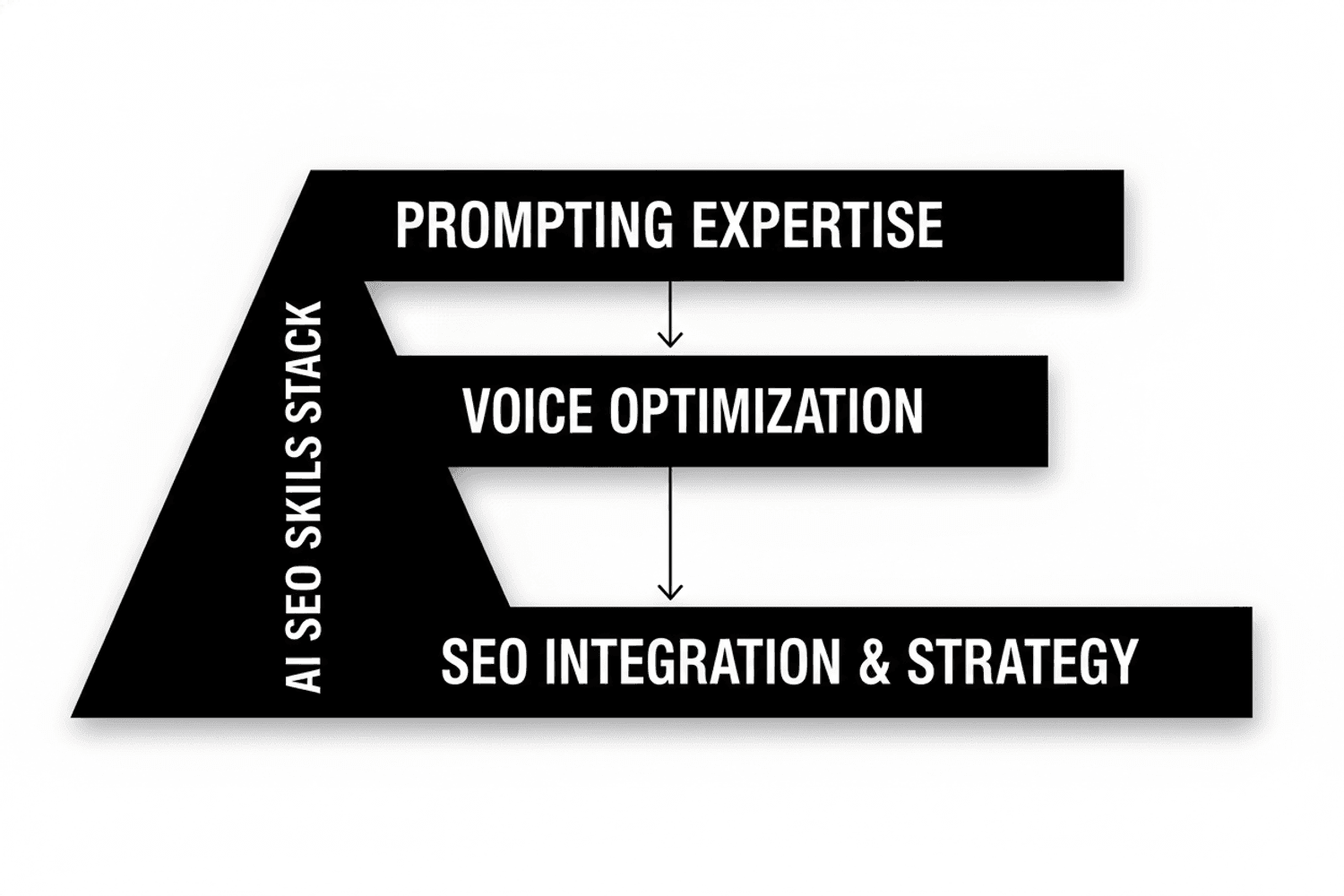

How to Use AI in SEO: The Human-in-the-Loop Strategy
Here’s where everything changes.
Using AI to make ourselves more efficient means the output we put out is of higher quality and increased amount. That’s kind of where we’re at right now.
How can we make ourselves more efficient and more accurate where my team isn’t as much doing as being the quality control? They’re being the human in the loop.
The human-in-the-loop framework recognizes that AI and humans excel at different things. When you combine them strategically, you get results neither could achieve alone.
AI’s Role: Efficiency and Processing Power
AI tools are exceptional at tasks that require speed, pattern recognition, and data processing at scale.
Here’s what AI does exceptionally well in SEO workflows:
- Keyword research: Analyzing search volume, competition, and opportunity across thousands of keyword ideas in minutes
- Content creation process acceleration: Generating first drafts, outlines, or section expansions that humans can refine
- Data analysis: Identifying patterns in analytics data, competitor strategies, or ranking factors
- Repetitive optimization: Updating meta descriptions, alt text, or structured data across large sites
- Catching oversights: Flagging missing keywords, thin content, or technical issues humans might miss in large datasets
AI powered tools can process more information faster than any human team. That processing power becomes your competitive advantage when you direct it strategically with human insight.
Human Expertise: The Quality Gate and “Final Cherry on Top”
Our team isn’t here to just crank out content. They’re the quality control. They’re the human in the loop. They’re the ones that know the area, emotion. They can humanize and although our tools are getting better at that—we can imitate the brand’s voice—I still have to have the human in the loop for that final cherry on top.
Emotional intelligence AI can’t replicate shows up in:
- Understanding when to be empathetic vs. authoritative
- Recognizing cultural context and sensitive topics
- Knowing what your specific audience finds helpful vs. annoying
- Catching tone-deaf statements that would damage trust
Area knowledge and context means your team knows:
- Industry-specific terminology and how professionals actually talk
- What’s actually happening in your market right now
- Which competitors are doing what, and how to differentiate
- What your clients ask about most frequently
Brand voice humanization and authenticity requires:
- Catching the generic AI phrases that don’t sound like you
- Adding the specific examples and stories that build credibility
- Maintaining consistency across all your content
- Ensuring every piece sounds like it came from the same company
The human expertise that separates good from great is the human element AI can assist with but never fully replace. That’s where your value is. That’s where your team’s value is.
Making Your Team More Efficient, Not Redundant
Here’s what happens when you implement the human-in-the-loop framework correctly:
Your team’s output volume increases WITHOUT quality sacrifice. Instead of writing 2 blog posts per week, they might produce 5-6. But each one maintains the expertise, voice, and strategic positioning that makes content actually perform.
Team focus shifts from creating content to being quality control. Writers become editors and strategists. Instead of staring at blank pages, they’re refining, enhancing, and directing AI output toward specific goals.
This preserves value for everyone involved. Clients get more content without paying 3x the price. Your team develops higher-level skills in strategy and quality assessment. And the content marketing operation becomes sustainably scalable instead of perpetually bottlenecked.
I want to make sure that my value is there. My team’s value is there. So using these systems to make ourselves more efficient means the output we put out is of higher quality and increased amount.
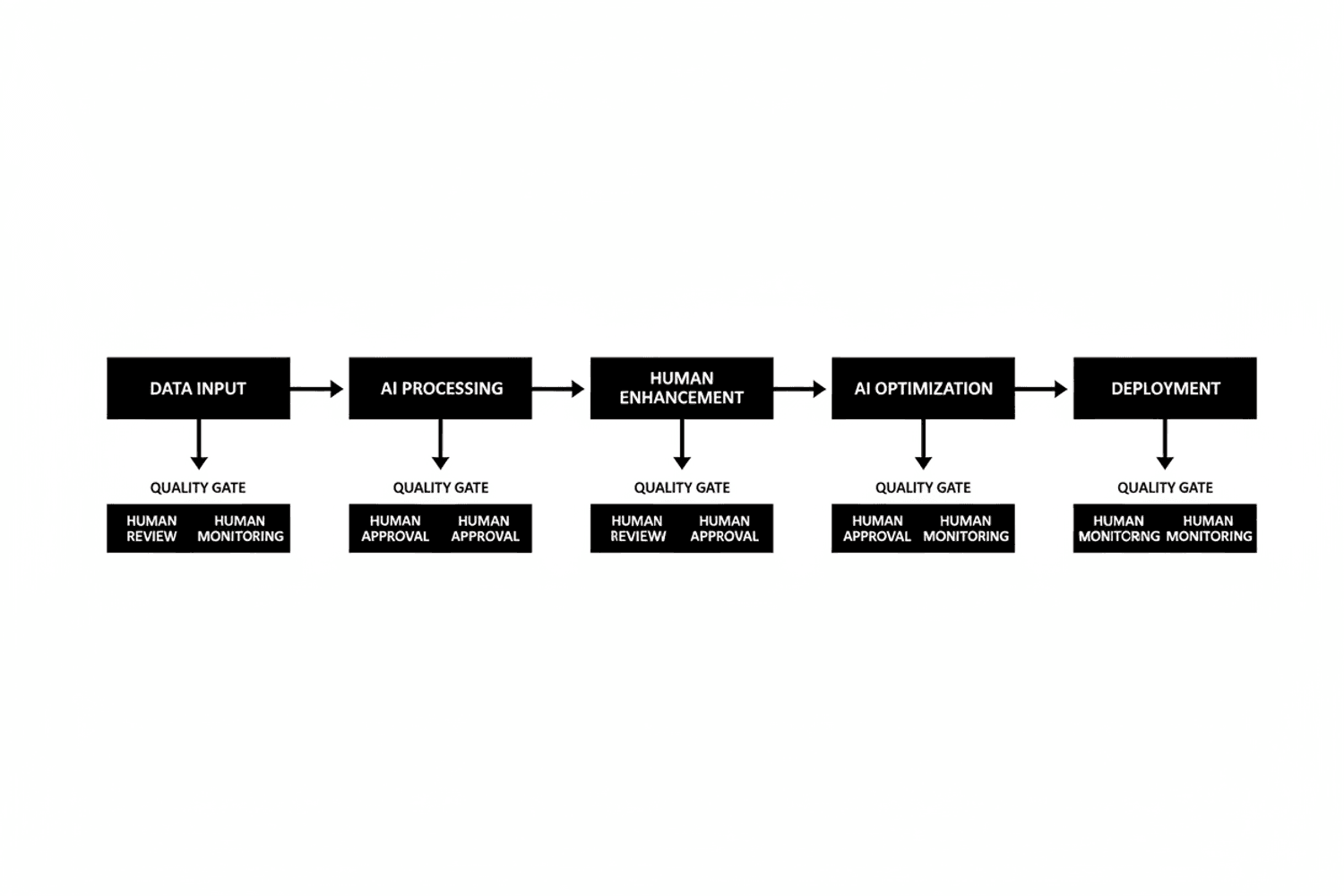

AI Tools for Content Creation Worth Using
Not all AI tools are created equal.
After testing dozens of AI powered seo tools, here’s what actually adds value when combined with human expertise.
Keyword Research and Search Intent Analysis
AI tools excel at keyword research because they can process massive datasets and identify patterns humans would miss.
The best tools in this category help you:
- Discover long-tail keyword opportunities with clear search intent
- Classify keywords by intent type (informational, commercial, transactional)
- Identify competitive gaps where you can realistically rank in Google search
- Analyze user search intent patterns across related queries
- Generate keyword ideas based on semantic relationships and AI driven search results
These tools don’t replace keyword strategy—they accelerate research so you can spend more time on strategic decisions about which keywords to target and why.
AI Content Generation and Optimization
This is where AI content generation adds the most value: creating first drafts and suggesting optimizations.
Content optimization tools analyze top-ranking pages for your target keywords and suggest:
- Topics and subtopics to cover comprehensively
- Related terms and semantic keywords to include naturally
- Content structure recommendations (headings, word count)
- Readability improvements and formatting suggestions
The key is treating these as suggestions, not mandates. The tool might recommend 3,000 words, but if your audience prefers concise content, human judgment overrides the AI recommendation.
Quality vs. quantity balance remains critical. Generate content that serves users who visit directly, not just content designed to game search traffic. When creating content with AI assistance, always prioritize serving your actual readers.
Technical SEO and Data Analysis
AI for technical audits and problem identification catches issues humans miss simply because sites are too large to review manually.
These tools excel at:
- Crawling thousands of pages to identify broken links, redirect chains, and indexing issues
- Large-scale data pattern recognition across analytics platforms
- Automated reporting that highlights the metrics that actually matter
- Tracking ranking changes across hundreds of keywords simultaneously
For enterprise sites with thousands of pages, AI analysis becomes essential. There’s simply no way to maintain technical SEO at scale without automation.
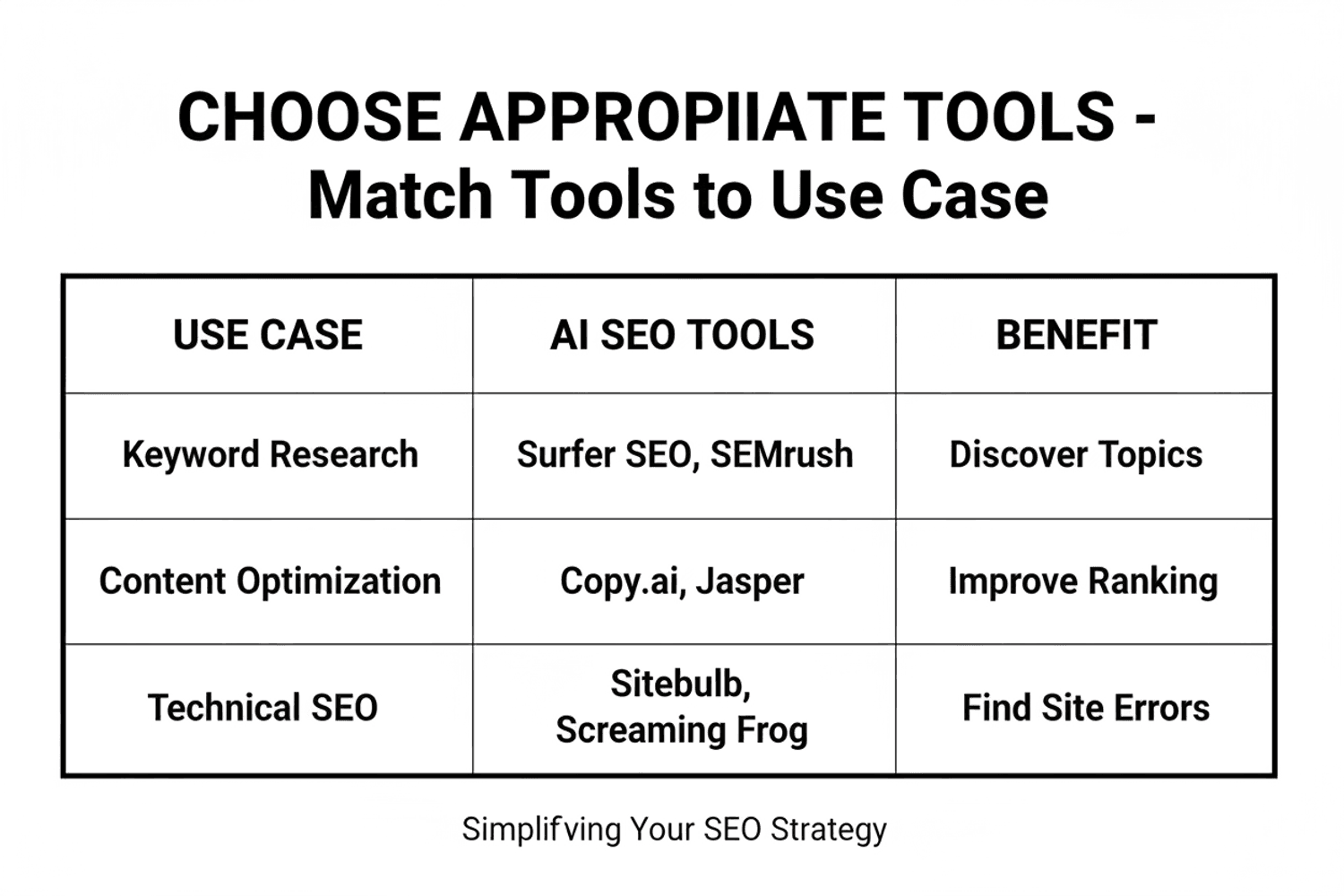

Why AI SEO Fails: Mistakes That Kill Results
Most AI SEO failures follow predictable patterns.
Here’s what goes wrong and how to avoid it.
The “Set It and Forget It” Trap
Automation without monitoring fails spectacularly in SEO.
Here’s why: search engines constantly update their algorithms. Competitors adjust their strategies. Your audience’s needs evolve. If you automate content creation and never review what’s actually publishing, you’ll miss all of these changes.
Quality degradation over time is guaranteed without oversight. AI models occasionally “drift” and start producing different output than when you first configured them. Brand voice inconsistencies creep in. Factual errors slip through.
Missing strategic opportunities hurts too. Maybe a competitor stumbles. Maybe a new keyword opportunity emerges. Maybe search intent shifts for your core topics. Automated systems won’t notice or adapt—humans have to catch these changes and adjust strategy accordingly.
Sacrificing Brand Voice for SEO Scores
Some AI SEO tools provide content scores and suggest changes to hit 90% or 95% optimization.
Here’s the problem: chasing perfect scores often damages content quality.
When optimization damages authenticity, you lose the very thing that makes content valuable. Readers can tell when you’re stuffing keywords unnaturally. They notice when every paragraph sounds like it was written by algorithm rather than a person who actually understands the topic.
The readability vs. keyword density balance matters more than perfect tool scores. Sometimes the best content for users includes slightly fewer keyword variations than AI recommends. That’s fine. Google’s algorithm is sophisticated enough to understand semantic relationships and topical relevance without requiring exact keyword repetition.
Maintaining human connection in AI-assisted content means occasionally ignoring the tool’s suggestions. If a sentence sounds better with 8 words instead of 25, keep it short. If a conversational aside improves engagement but doesn’t include keywords, include it anyway.
Ignoring Search Engine Guidelines on AI Content
Google’s stance on AI-generated content is clear, but many marketers misunderstand it.
According to Google’s official documentation updated in May 2025, they don’t penalize AI content based on how it’s created. They penalize content created “with the primary purpose of manipulating search rankings.”
The “helpful content” standard applies to all content equally—human or AI. Google evaluates:
- E-E-A-T signals: Experience, Expertise, Authoritativeness, Trustworthiness
- Value to users: Does this answer their question comprehensively?
- Originality: Does this add something new or just rehash existing content?
- Intent match: Does this satisfy what the searcher was looking for?
How to stay compliant while using AI:
- Add human expertise and first-hand experience to AI drafts
- Verify all facts and remove any AI hallucinations
- Ensure content serves users, not just search engines
- Maintain high E-E-A-T standards, especially for YMYL topics
Recent data shows 86.5% of top 20 Google positions contain at least partially AI-generated content. AI usage isn’t the issue—quality is.
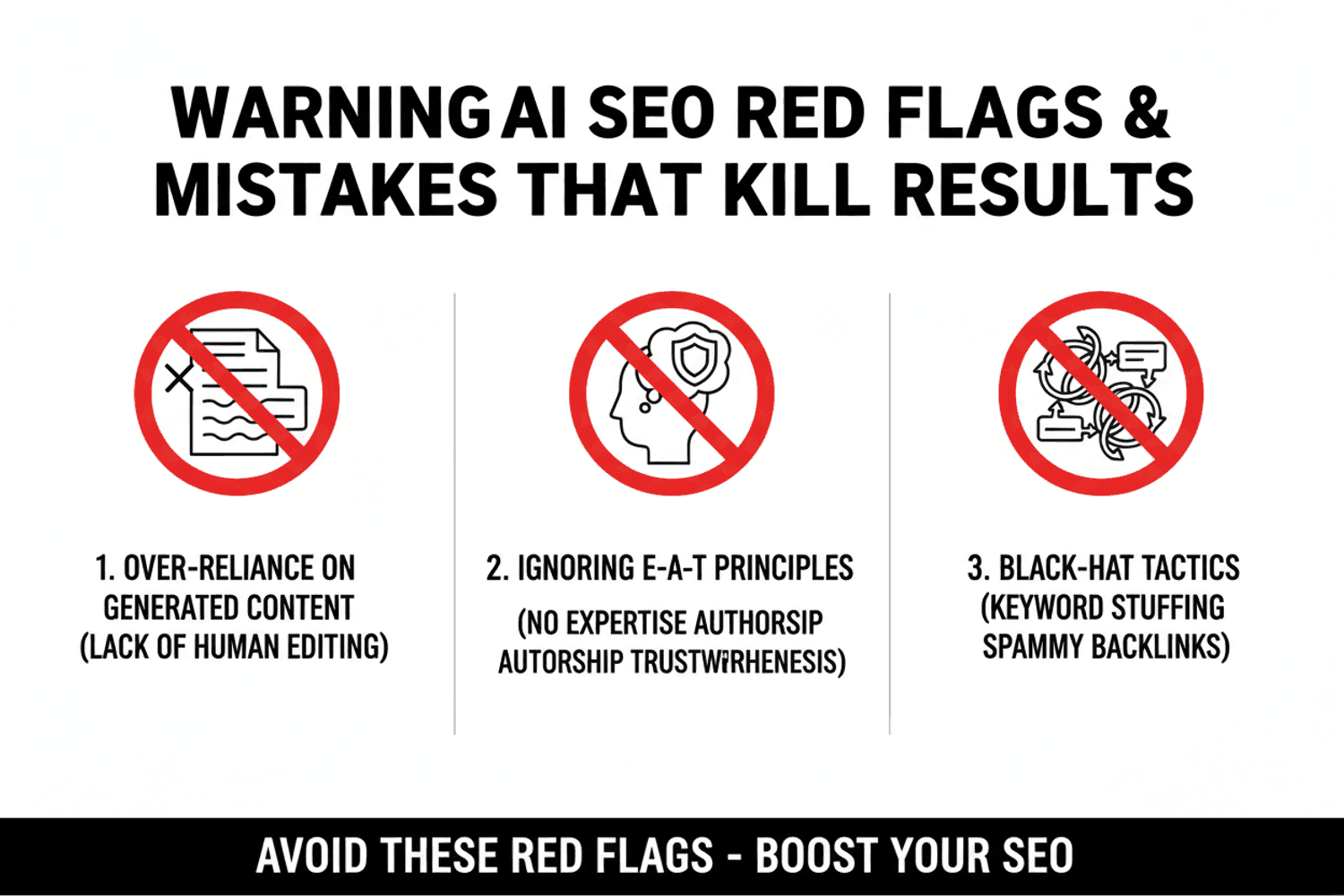

How to Test If Your AI SEO Approach Actually Works
That’s why we test things.
First of all, we want to understand it. When people say “hey I think I’m going to do this,” I want to be able to tell them okay, but here’s what you’re going to get. Here’s the output of that.
Testing isn’t optional in AI SEO. It’s how you determine what actually works versus what sounds good in theory.
Setting Up Proper Testing
What to measure: rankings in search results, traffic, engagement, conversions. You need all four.
Rankings tell you if search engines notice your content. Traffic shows if people click. Engagement metrics (time on page, scroll depth, bounce rate) reveal if content is actually helpful. Conversions prove business value.
Control groups and A/B testing approaches work when possible. Can you publish some AI-assisted content and some fully human-written content targeting similar keywords? Compare performance over 60-90 days.
Timeline expectations matter. AI SEO isn’t instant. Search engines need time to crawl, index, and evaluate content. Expect:
- 2-4 weeks for initial indexing
- 4-8 weeks for ranking stabilization
- 3-6 months for full performance assessment
Don’t abandon strategies after two weeks. But also don’t waste six months on approaches that show zero movement after 8 weeks.
Learning From What Doesn’t Work
Failed tests teach as much as successes—maybe more.
When AI-generated content fails to rank, ask:
- Did we miss search intent? Maybe the keyword meant something different than we assumed.
- Is E-E-A-T insufficient? Does the content lack credible author attribution or expertise signals?
- Did competitors outperform us on depth? Sometimes ranking requires 3,000 words when you published 1,500.
- Are technical issues blocking indexing? Check Search Console for crawl errors or indexing problems.
Common failure patterns to recognize include:
- Thin content that doesn’t differentiate from competitors
- Generic AI voice that lacks brand personality
- Keyword stuffing that triggers spam filters
- Publishing velocity that’s too aggressive (sudden spikes trigger scrutiny)
When to pivot vs. fine tune: If a strategy shows no improvement after 8 weeks, pivot. If you see some traction but not enough, fine tune and give it another 4-6 weeks.
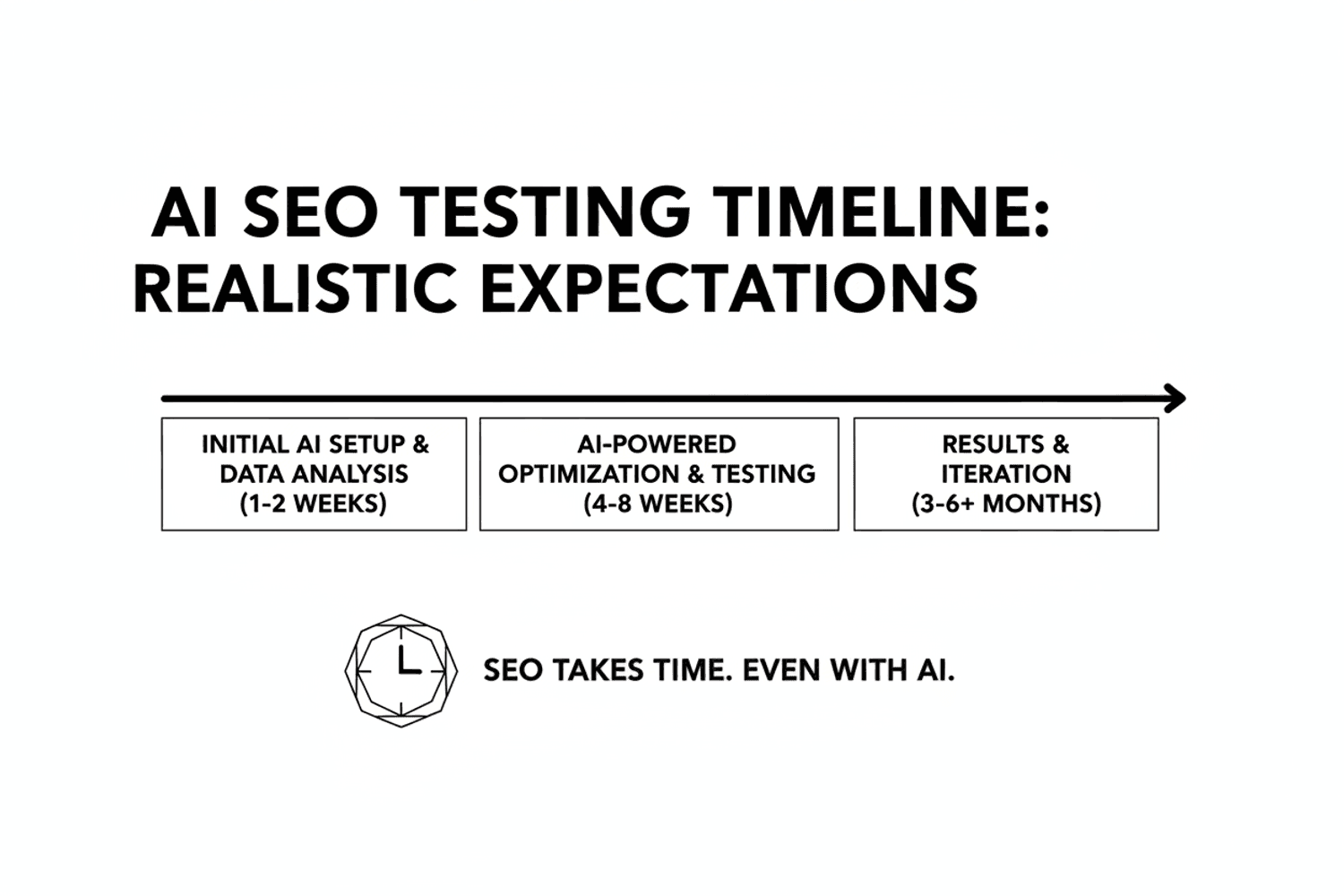

Start Using AI in SEO the Right Way Today
The human-in-the-loop philosophy means treating AI as a capability amplifier, not a volume multiplier.
It means understanding that your value and your team’s value remain essential. AI makes you more efficient and accurate. It shifts your focus from doing to being quality control. But the strategic thinking, the expertise, the brand voice—that’s still you.
Testing mindset is your competitive advantage. Most businesses use AI because everyone else is. They don’t test. They don’t measure. They don’t refine. That’s why they get mediocre results and blame the tool.
Your first step: Assess your current SEO knowledge and AI literacy. Be honest. If you don’t understand how search engines evaluate content quality, AI won’t magically fix that gap.
Second: Choose one area to test AI assistance—either keyword research OR content optimization. Don’t try to automate everything at once. Master one application before expanding.
Third: Implement human review gates at every stage. AI drafts get human editing. AI keyword suggestions get strategic validation. AI optimization recommendations get sanity checks against brand voice and user needs.
Document what works for systematic improvement. Keep notes on which prompts produce the best results. Track which content types benefit most from AI assistance. Build institutional knowledge about your specific use cases.
If you need help implementing AI into your SEO strategy without sacrificing quality, RobbenMedia specializes in human-in-the-loop AI content that ranks well AND reads naturally. We test everything systematically because we want to understand it—and we want you to understand exactly what you’ll get.
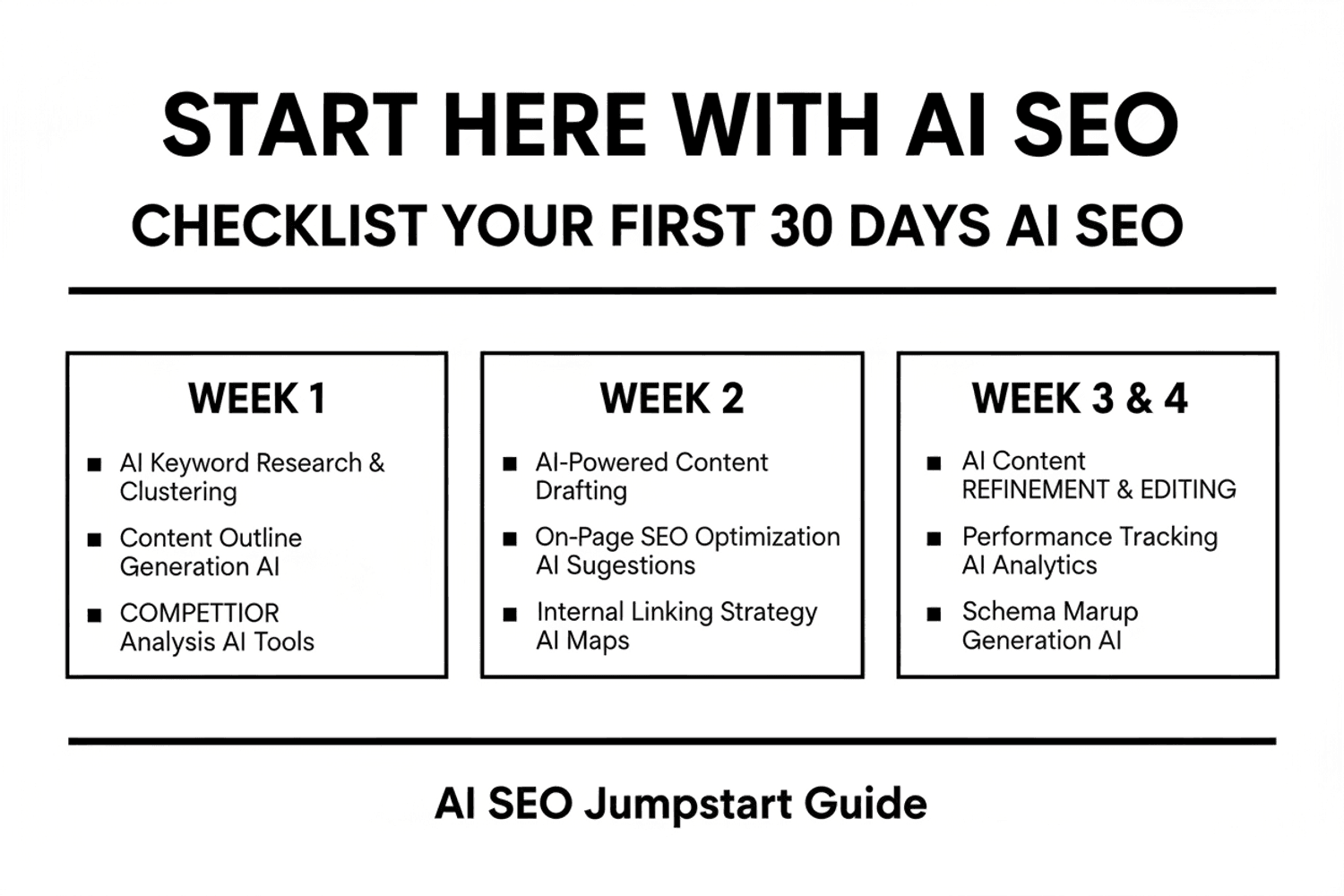

Frequently Asked Questions
Is AI Generated Content Bad for SEO?
Not inherently. Search engines like Google care about content quality and helpfulness, not whether AI was involved in creation.
According to recent industry data, 86.5% of top 20 Google positions contain at least partially AI-generated content. The problem arises when AI content lacks human expertise, fails to address search intent, or reads generically.
With proper human oversight—the “human in the loop” approach—AI becomes a tool for efficiency without sacrificing the quality signals search engines reward. Google explicitly states they don’t penalize content based on creation method, only on whether it provides genuine value to users.
What’s the Difference Between AI SEO Tools and Traditional Tools?
Traditional SEO tools analyze data and provide insights, but you interpret and act on them manually.
AI SEO tools attempt to automate the interpretation and action—keyword research suggestions, content generation, optimization recommendations. The catch? AI tools still need human expertise to set direction, validate outputs, and ensure quality.
Think of AI as accelerating what you already know how to do, not replacing the need to know it. If you don’t understand SEO fundamentals, AI tools will just help you make mistakes faster. For specialized applications like managing your Google Business Profile or implementing WordPress plugin integrations, human oversight remains critical.
How Much Does AI Actually Speed Up SEO Work?
In our testing, AI can increase content output by 200-300% when properly implemented with human quality control.
But “speed up” is misleading—AI shifts your team from creating content to quality controlling and refining, which means you produce more without sacrificing standards.
The speed comes from efficiency, not from removing human involvement. Those who try to remove humans entirely see volume increase but quality and results decline. The content creation process becomes faster when AI handles first drafts and humans focus on strategic refinement, expertise addition, and brand voice consistency.




